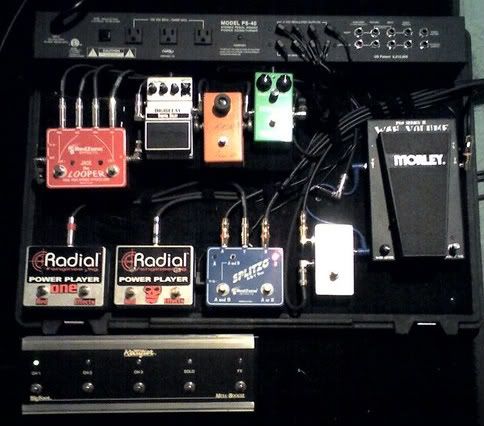LEVEL4
Well-known member
I promised myself that I wouldn't start this thread until I could post some clips, but I just couldn't resist. To any of you who own a Mark IV—buy a DC-3. And to those of you who own a DC-series amp—buy a Mark IV. A/B/Y these two amps together, and you'll have the sweetest lead tone ever. I actually think this works with any two Mesa/Boogie amps with GEQs, but, it seems to work best with a combination of a natively "dark" amp (DC-series), and a natively "tight" amp (Mark IV).
Here's my lead set-up:
• Mark IV rackmount head ("bright" amp).
• AudioTechnica AT3035 large-diaphragm condenser mic.
• DC-3 rackmount head ("dark" amp).
• Roland Space Echo RE-20 re-issue in DC-3 parallel effects loop, mixed at 50%.
• Shure SM57 dynamic mic.
• Voodoo Lab Amp Selector A/B/C/D switch.
Here's my rhythm set-up:
• Single-Recto Solo 50 head ("bright" amp).
• AudioTechnica AT3035 large-diaphragm condenser mic.
• Peavey 6505 head ("dark" amp).
• Shure SM57 dynamic mic.
• Voodoo Lab Amp Selector A/B/C/D switch.
Similar to the lead set-up, I have a "bright" amp (Single-Recto) A/B/Y'd with a "dark" amp (6505). Someday, I want to change out the 6505 to a Soldano SLO100, or just have the 6505 modded by Jerry at FJAmods.
The trick is to EQ each amp, in each A/B/Y set-up, to be of contrasting EQ profiles—one dark, and one bright. With this strategy, you get both the tight high-end, which gives you that biting attack and definition, combined with the deep, aggressive tones that give you that mid-range growl. This would also work with two identical amps (e.g., two Mark IIIs), each EQ'd in opposing fashions, although it's easiest if the amps' voicings are already different to begin with. Try it. I guarantee, you'll never go back to a single-amp, set-up again. Also, note that I record the "dark" amps with a darker, "mid-rangey" mic (SM57), and the "bright" amps with a brighter, "high-frequency response" mic (AT3035 condenser) to both accentuate and complement each amps' voicings.
Here's my lead set-up:
• Mark IV rackmount head ("bright" amp).
• AudioTechnica AT3035 large-diaphragm condenser mic.
• DC-3 rackmount head ("dark" amp).
• Roland Space Echo RE-20 re-issue in DC-3 parallel effects loop, mixed at 50%.
• Shure SM57 dynamic mic.
• Voodoo Lab Amp Selector A/B/C/D switch.
Here's my rhythm set-up:
• Single-Recto Solo 50 head ("bright" amp).
• AudioTechnica AT3035 large-diaphragm condenser mic.
• Peavey 6505 head ("dark" amp).
• Shure SM57 dynamic mic.
• Voodoo Lab Amp Selector A/B/C/D switch.
Similar to the lead set-up, I have a "bright" amp (Single-Recto) A/B/Y'd with a "dark" amp (6505). Someday, I want to change out the 6505 to a Soldano SLO100, or just have the 6505 modded by Jerry at FJAmods.
The trick is to EQ each amp, in each A/B/Y set-up, to be of contrasting EQ profiles—one dark, and one bright. With this strategy, you get both the tight high-end, which gives you that biting attack and definition, combined with the deep, aggressive tones that give you that mid-range growl. This would also work with two identical amps (e.g., two Mark IIIs), each EQ'd in opposing fashions, although it's easiest if the amps' voicings are already different to begin with. Try it. I guarantee, you'll never go back to a single-amp, set-up again. Also, note that I record the "dark" amps with a darker, "mid-rangey" mic (SM57), and the "bright" amps with a brighter, "high-frequency response" mic (AT3035 condenser) to both accentuate and complement each amps' voicings.
























